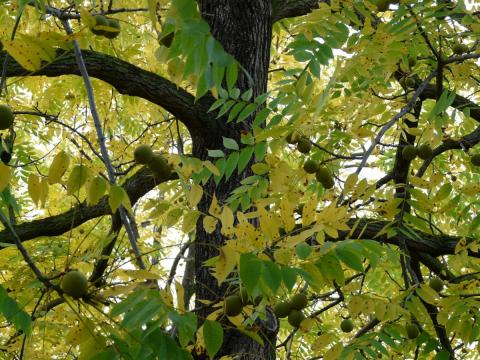Are black walnut trees bad for gardens?

Black walnut (Juglans nigra) is considered one of the most valuable trees native to North America. Its wood is valuable for furniture and cabinet making and its edible nuts are harvested for commercial sale. Black walnut is also a stately landscape tree with a long trunk and open branching habit that make it a popular choice for parks and large landscapes. However, planting beneath or very close to a black walnut can be problematic due to the tree’s production of biochemicals that can inhibit the growth of certain plants. This chemical inhibition is known as allelopathy and is well documented in black walnut as well as several other species (e.g. tree of heaven, hickory, black cherry, red oak, black locust and sassafras). Allelopathy is a strategy that many plants have developed to help assure their survival by inhibiting the germination and growth of nearby plants, leaving more water, light and nutrients for the victor.
Allelopathic Toxicity: Juglone
Black walnuts exude a biochemical called juglone from nearly all plant parts, including roots, decaying leaves, twigs, nut hulls and inner bark. Competing plantings that are sensitive to juglone will typically develop yellowed, wilting leaves, particularly during hot and dry weather. While these symptoms may initially appear to be from water stress, applying irrigation will not cause them to perk up. In fact, wilting from juglone exposure will sometimes occur when the soil is moist. Eventually, affected plants will die. Plants that grow directly beneath the canopy of a black walnut are at greatest risk. Their roots are likely to come in contact with black walnut roots, and juglone can accumulate in saturated soils from fallen leaves, twigs and nut hulls.
Fortunately, juglone is only very toxic to certain plants such as rhododendron, mountain laurel, blueberry, chrysanthemum, lily-of-the-valley, peony and solanaceous crops (tomatoes, eggplant, peppers and potatoes). Many other plants are tolerant and can be grown in the vicinity of black walnut trees without harm. Allelopathic toxicity can be entirely avoided by placing gardens far away from black walnuts or planting in lined raised beds that limit root contact. Adding organic matter to the soil to improve drainage helps boost the activity of microorganisms that break down toxins, and cleaning up fallen leaves, hulls and stems can reduce the amount of juglone incorporated into the soil. Ultimately, black walnut trees aren’t necessarily bad for gardens but they can be problematic if trying to grow certain plants nearby. As long as you plan your garden carefully and thoughtfully, a black walnut tree can be great addition to the yard.
Got questions? The Ask UNH Extension Infoline offers practical help finding answers for your home, yard, and garden questions. Call toll free at 1-877-398-4769, Monday to Friday, 9 a.m. to 2 p.m., or e-mail us at answers@unh.edu.
Do you love learning about stuff like this?
SUBSCRIBE TO Granite State Gardening newsletter
Got questions? The UNH Extension Yard and Garden Infoline offers practical help finding answers for your yard and garden questions.
Call toll free at 1-877-398-4769, Monday to Friday, 9 a.m. to 2 p.m., or fill out webform.
